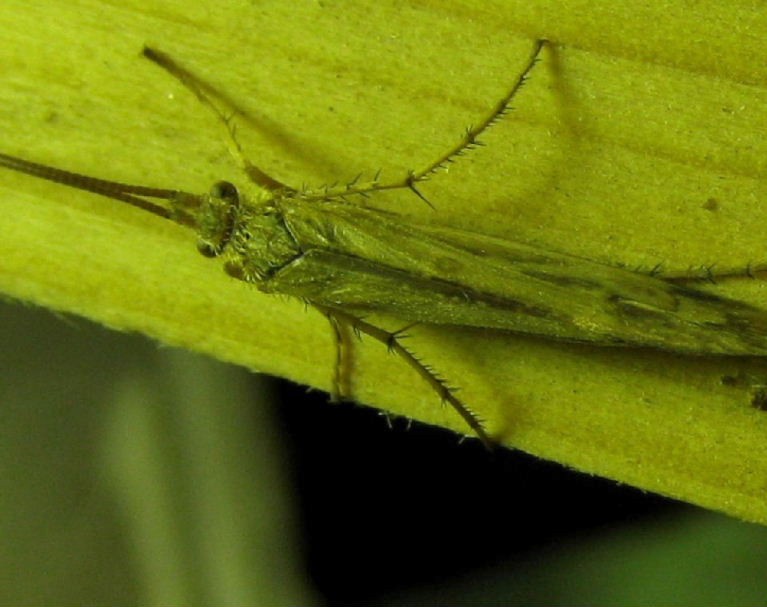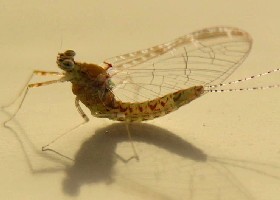Caddis Flies/Caddisflies
 Limnephilus lunatus
Limnephilus lunatus
 10-15mm long. Half moon on tail.
10-15mm long. Half moon on tail.
 Makes larval case from debris (leaves/sand).
Makes larval case from debris (leaves/sand).
Caddis Flies (also Caddisflies), like Moths, are mainly nocturnal and attracted to light. There are some 200 species in the UK alone.
Like Stoneflies and Mayflies, their larvae are aquatic.
(Oxford Dictionary spells it "Caddis-flies," but I've not seen that elsewhere, and says the larvae are "Caddis-worms" or just "Caddis.")
(Oxford Dictionary spells it "Caddis-flies," but I've not seen that elsewhere, and says the larvae are "Caddis-worms" or just "Caddis.")
 Agrypnia varia
Agrypnia varia
 12-18mm long
12-18mm long
 Tube case makers
Tube case makers
The adults have extremely long antennae, often as long as the body, and varied patterns on their wings but usually in drab colours (many are plain).
They are not true flies, having two pairs of wings. Related to Lepidoptera, their wings have hair rather than the scales of Moths/Butterflies. Adults do not usually eat.
They are not true flies, having two pairs of wings. Related to Lepidoptera, their wings have hair rather than the scales of Moths/Butterflies. Adults do not usually eat.
 Mystacides longicornis
Mystacides longicornis
 6-9mm long. Distinctive pattern.
6-9mm long. Distinctive pattern.
 Larval case made of sand grains and small stones.
Larval case made of sand grains and small stones.
Caddisfly larvae "construct" cases, tubes or nets of silk, gravel and other materials under water to hide, catch prey or pupate.



Some larvae are predators, some vegetarian. Larvae and adults are an important food source for fish, birds, amphibians and other insects.



The presence of many larvae is also an indication of the cleanliness of a water source.

 Limnephilus sparsus 10-13mm long.
Limnephilus sparsus 10-13mm long.
 Mystacides nigra? 7-10mm long.
Mystacides nigra? 7-10mm long.
 Another Limnephilus lunatus, posing on Martin.
Another Limnephilus lunatus, posing on Martin.
 The angular Mystacides azurea, 6-9mm long.
The angular Mystacides azurea, 6-9mm long.
The two photos immediately above were kindly provided by Martin Starnes.
 Males have large, hairy maxillary palps used in mating as they fly above water in a swarm with vertical
zig zag movements (hence US common name Black Dancer for similar species).
Males have large, hairy maxillary palps used in mating as they fly above water in a swarm with vertical
zig zag movements (hence US common name Black Dancer for similar species).


